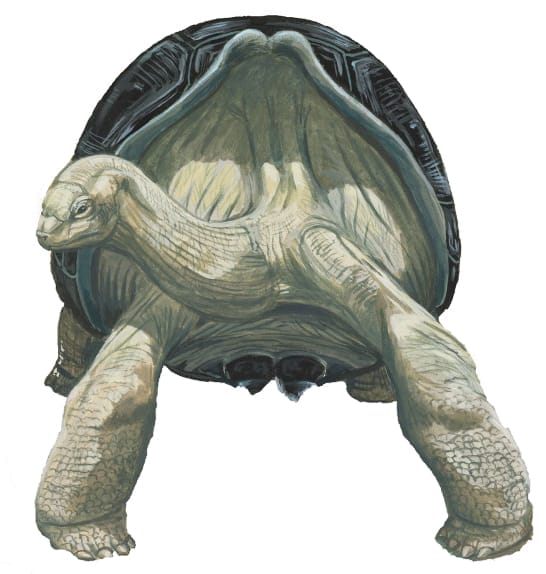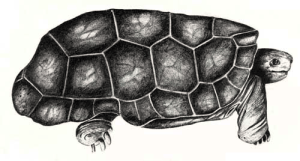Cylindraspis triserrata (Domed Mauritius Giant Tortoise)
Home > Turtle Database > Cylindraspis triserrata (Domed Mauritius Giant Tortoise)
Cylindraspis triserrata, commonly known as the Mauritius Domed Tortoise, was a large, slow-moving tortoise species that once roamed the islands of Mauritius. It became extinct due to human activities and invasive species during the 18th century.
Native To These Regions
MauritiusNative Turtle Species Map – Find Turtles by Region
Scientific Classification
- Kingdom: Animalia
- Phylum: Chordata
- Class: Reptilia
- Order: Testudines
- Family: Testudinidae
- Genus: Cylindraspis
- Species: Cylindraspis triserrata
Common Names
- Domed Mauritius Giant Tortoise
This Hilarious Turtle Book Might Know Your Pet Better Than You Do
Let’s be real—most turtle care guides feel like reading a textbook written by a sleep-deprived zookeeper.
This one’s not that.
Told from the snarky point of view of a grumpy, judgmental turtle, 21 Turtle Truths You’ll Never Read in a Care Guide is packed with sarcasm, sass, and surprisingly useful insights.
And hey—you don’t have to commit to the whole thing just yet.
Grab 2 free truths from the ebook and get a taste of what your turtle really thinks about your setup, your food choices, and that weird plastic palm tree.
It’s funny, it’s honest, and if you’ve ever owned a turtle who glares at you like you’re the problem—you’ll feel seen.
Identification
Description
Cylindraspis triserrata had a high-domed shell and a relatively large body, reaching up to 50 cm (20 inches) in length. The shell was light brown to grayish and featured a unique shape with three distinct serrations or ridges along the carapace, giving the species its name. The legs were sturdy, and it had a slow, lumbering gait typical of tortoises.
Sexual Dimorphism
Males were generally larger than females, with more pronounced serrations on their shells. Additionally, males had longer tails, which is common among tortoise species.
Check more turtles from the Cylindraspis genus
Native Origin and Distribution
Geographical Range
Cylindraspis triserrata was endemic to the island of Mauritius, specifically in the highland and coastal regions. It shared its range with other species of the Cylindraspis genus, which also faced extinction.
Preferred Habitat
This species preferred grasslands, open forests, and coastal areas where they could graze on vegetation. The environment provided ample food sources like grasses, shrubs, and low-growing plants.
Behavior
Feeding Habits
Cylindraspis triserrata was a herbivore, feeding on grasses, leaves, and shrubs. Its diet also included fruits and fallen vegetation, which were abundant in its natural habitat.
Predators
As an adult, it had few natural predators due to its large size and tough shell. However, hatchlings and juveniles were vulnerable to invasive species such as rats and pigs introduced by humans.
Reproduction
Breeding Season
Breeding likely occurred during the warmer months, with nesting taking place once or twice a year, though detailed records are scarce due to the species’ early extinction.
Reproductive Method
Females laid eggs in shallow nests, typically on sandy or soft soil. Clutches consisted of multiple eggs, and hatchlings would emerge after an incubation period of a few months.
Conservation
Extinction Status
Extinct. Cylindraspis triserrata was driven to extinction in the 1700s due to overhunting by humans and habitat destruction.
Threats
The main threats were overexploitation by sailors who collected the tortoises for food and introduced animals like rats and pigs that preyed on the eggs and young tortoises.
Conservation Measures
Sadly, no conservation efforts were made for this species at the time, as it went extinct before formal conservation practices were developed.
Economic Importance
Historically, Cylindraspis triserrata was hunted for its meat, which was a vital food source for sailors on long voyages. Its shells may also have been used in local trade or crafts.
Interesting Facts
- Cylindraspis triserrata was one of five tortoise species in the genus Cylindraspis that lived on Mauritius.
- This species played a crucial role in seed dispersal for several native plants in Mauritius.
- It is believed that these tortoises could survive for months without food, making them ideal for long sea voyages.

About Author
Muntaseer Rahman started keeping pet turtles back in 2013. He also owns the largest Turtle & Tortoise Facebook community in Bangladesh. These days he is mostly active on Facebook.















